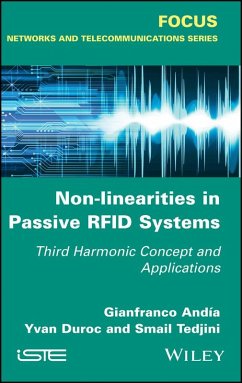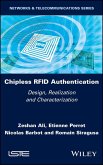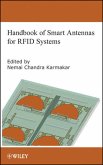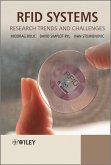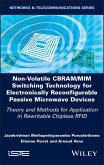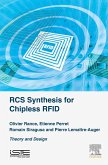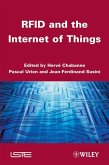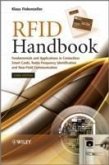Gianfranco Andia, Yvan Duroc, Smail Tedjini
Non-Linearities in Passive RFID Systems (eBook, ePUB)
Third Harmonic Concept and Applications
139,99 €
inkl. MwSt.
Sofort per Download lieferbar

0 °P sammeln
Gianfranco Andia, Yvan Duroc, Smail Tedjini
Non-Linearities in Passive RFID Systems (eBook, ePUB)
Third Harmonic Concept and Applications
- Format: ePub
- Merkliste
- Auf die Merkliste
- Bewerten Bewerten
- Teilen
- Produkt teilen
- Produkterinnerung
- Produkterinnerung

Bitte loggen Sie sich zunächst in Ihr Kundenkonto ein oder registrieren Sie sich bei
bücher.de, um das eBook-Abo tolino select nutzen zu können.
Hier können Sie sich einloggen
Hier können Sie sich einloggen
Sie sind bereits eingeloggt. Klicken Sie auf 2. tolino select Abo, um fortzufahren.

Bitte loggen Sie sich zunächst in Ihr Kundenkonto ein oder registrieren Sie sich bei bücher.de, um das eBook-Abo tolino select nutzen zu können.
This book concerns a new paradigm in the field of UHF RFID systems: the positive exploitation of nonlinear signals generated by the chips integrated into the RFID tags. After having recalled the main principles in RFID technology and its current challenges notably with the emergence of Internet of Things or the smart connected environments, the purpose is to focus on the presence of nonlinearities produced by the nonlinear circuits of RFID chips: effects, nuisances and solutions but also and especially use of the phenomena. The presentation covers all aspects from the characterization of the…mehr
- Geräte: eReader
- mit Kopierschutz
- eBook Hilfe
- Größe: 15.29MB
Andere Kunden interessierten sich auch für
![Chipless RFID Authentication (eBook, ePUB) Chipless RFID Authentication (eBook, ePUB)]() Zeshan AliChipless RFID Authentication (eBook, ePUB)126,99 €
Zeshan AliChipless RFID Authentication (eBook, ePUB)126,99 €![Handbook of Smart Antennas for RFID Systems (eBook, ePUB) Handbook of Smart Antennas for RFID Systems (eBook, ePUB)]() Handbook of Smart Antennas for RFID Systems (eBook, ePUB)148,99 €
Handbook of Smart Antennas for RFID Systems (eBook, ePUB)148,99 €![RFID Systems (eBook, ePUB) RFID Systems (eBook, ePUB)]() RFID Systems (eBook, ePUB)116,99 €
RFID Systems (eBook, ePUB)116,99 €![Non-Volatile CBRAM/MIM Switching Technology for Electronically Reconfigurable Passive Microwave Devices (eBook, ePUB) Non-Volatile CBRAM/MIM Switching Technology for Electronically Reconfigurable Passive Microwave Devices (eBook, ePUB)]() Jayakrishnan M. PurushothamaNon-Volatile CBRAM/MIM Switching Technology for Electronically Reconfigurable Passive Microwave Devices (eBook, ePUB)139,99 €
Jayakrishnan M. PurushothamaNon-Volatile CBRAM/MIM Switching Technology for Electronically Reconfigurable Passive Microwave Devices (eBook, ePUB)139,99 €![RCS Synthesis for Chipless RFID (eBook, ePUB) RCS Synthesis for Chipless RFID (eBook, ePUB)]() Olivier RanceRCS Synthesis for Chipless RFID (eBook, ePUB)55,95 €
Olivier RanceRCS Synthesis for Chipless RFID (eBook, ePUB)55,95 €![RFID and the Internet of Things (eBook, ePUB) RFID and the Internet of Things (eBook, ePUB)]() RFID and the Internet of Things (eBook, ePUB)139,99 €
RFID and the Internet of Things (eBook, ePUB)139,99 €![RFID Handbook (eBook, ePUB) RFID Handbook (eBook, ePUB)]() Klaus FinkenzellerRFID Handbook (eBook, ePUB)125,99 €
Klaus FinkenzellerRFID Handbook (eBook, ePUB)125,99 €-
-
-
This book concerns a new paradigm in the field of UHF RFID systems: the positive exploitation of nonlinear signals generated by the chips integrated into the RFID tags. After having recalled the main principles in RFID technology and its current challenges notably with the emergence of Internet of Things or the smart connected environments, the purpose is to focus on the presence of nonlinearities produced by the nonlinear circuits of RFID chips: effects, nuisances and solutions but also and especially use of the phenomena. The presentation covers all aspects from the characterization of the nonlinear behavior of RFID tags and the associated platforms (distinguishing conducted and radiated measurement) to the design of new types of tags where nonlinearities are exploited in order to offer new capabilities or enhanced performance.
Dieser Download kann aus rechtlichen Gründen nur mit Rechnungsadresse in D ausgeliefert werden.
Produktdetails
- Produktdetails
- Verlag: John Wiley & Sons
- Erscheinungstermin: 19. Januar 2018
- Englisch
- ISBN-13: 9781119490746
- Artikelnr.: 52556258
- Verlag: John Wiley & Sons
- Erscheinungstermin: 19. Januar 2018
- Englisch
- ISBN-13: 9781119490746
- Artikelnr.: 52556258
- Herstellerkennzeichnung Die Herstellerinformationen sind derzeit nicht verfügbar.
Gianfranco Andía is a Doctor in Radio Frequency from Grenoble Institute of Technology, France, and an RF engineer in the RFID industry.
Yvan Duroc is Full Professor at the University Claude Bernard Lyon 1, France.
Smail Tedjini is a URSI Fellow and IEEE Senior Member. He has been Professor at Grenoble Institute of Technology since 1996.
Yvan Duroc is Full Professor at the University Claude Bernard Lyon 1, France.
Smail Tedjini is a URSI Fellow and IEEE Senior Member. He has been Professor at Grenoble Institute of Technology since 1996.
Acknowledgments ix
Introduction xi
Chapter 1 History of Radio-frequency Identification: From Birth to Advanced
Applications 1
1.1 Early facts about the genesis of RFID 1
1.2 Birth of RFID 2
1.3 Early modern RFID 4
1.4 The 1970s: The infancy age of RFID 7
1.5 The 1980s and 1990s: Implementation of RFID 8
1.6 RFID chip age 10
1.7 Maturation of RFID 11
1.8 Internet of Things: The next RFID frontier 15
1.9 Summary 19
Chapter 2 RFID Technology: Main Principles and Non-linear Behavior of Tags
21
2.1 RFID: A multilayer vision 21
2.2 Focus on passive UHF RFID technology 23
2.2.1 Working principle 23
2.2.2 Reader 24
2.2.3 Tag 25
2.3 Non-linear RF networks and harmonic generation 29
2.3.1 Effects of a non-linear device 29
2.3.2 Theory on the effects of a non-linear device 29
2.4 Non-linear behavior and associated applications in the RFID field 32
2.4.1 Measurement of backscattered harmonics 32
2.4.2 Wireless sensor tags 33
2.5 Summary 37
Chapter 3 Characterization Platforms for Passive RFID Chips and Tags 39
3.1 Introduction 39
3.2 Measuring the backscattered tag response 41
3.2.1 Harmonic backscattering 41
3.2.2 Measurement techniques 41
3.2.3 RFID air interface 42
3.2.4 Configuration of the physical layer in the UHF RFID system 43
3.3 Characterization of RFID tags - radiated measurements 45
3.3.1 Tags under test 46
3.3.2 Measurement system 46
3.3.3 Power budget 47
3.3.4 Power tag sensitivity 48
3.3.5 Radar cross-section and physical surface of a tag 49
3.3.6 Optimized PSD analysis of the RFID communication 52
3.3.7 Dependency analysis of harmonic scattering 58
3.3.8 Limitations of tag characterization by radiated measurements 65
3.4 Characterization of RFID chips-conducted measurements 66
3.4.1 Non-linear characterization platform 68
3.4.2 System operation description 68
3.4.3 Activation threshold and impedance measurement 72
3.4.4 Harmonic characterization 75
3.4.5 Result exploitation 79
3.5 Summary 80
Chapter 4 Modeling the Harmonic Signals Produced by RFID Chips 81
4.1 Introduction 81
4.2 Analysis of harmonic currents in RFID chips 82
4.2.1 Review of Dickson analysis 82
4.2.2 Calculation of the harmonic currents 84
4.3 Third harmonic in traditional RFID tags 88
4.3.1 Impedance matching network for f0 88
4.3.2 Influence of Q in the backscattered signal at 3f0 89
4.4 How to profit from the third harmonic signal 93
4.4.1 Dual-band impedance matching network 93
4.4.2 Backscattered signal at 3f0 by the HT 95
4.5 Summary 96
Chapter 5 Applications: Augmented RFID Tags 99
5.1 Introduction 99
5.2 Harmonic communication in passive UHF RFID 101
5.2.1 A review of the regulations 102
5.2.2 Harmonic reader considerations 104
5.2.3 Harmonic tag design 104
5.2.4 Metrics to evaluate the harmonic RFID tags 106
5.2.5 Application case and experimental results: Harmonic tag design
example 108
5.2.6 Summary: Harmonic tag 128
5.3 Harmonic harvesting: Empowering the RFID tag 129
5.3.1 Harmonic generation in diode-based circuits 129
5.3.2 Techniques to empower the RFID chip and rectifier circuits in general
130
5.3.3 Third harmonic exploitation in passive RFID 132
5.3.4 Application case and experimental results 141
5.3.5 Summary: Harmonic harvesting 147
5.4 Conclusion 148
Conclusion 151
Bibliography 155
Index 171
Introduction xi
Chapter 1 History of Radio-frequency Identification: From Birth to Advanced
Applications 1
1.1 Early facts about the genesis of RFID 1
1.2 Birth of RFID 2
1.3 Early modern RFID 4
1.4 The 1970s: The infancy age of RFID 7
1.5 The 1980s and 1990s: Implementation of RFID 8
1.6 RFID chip age 10
1.7 Maturation of RFID 11
1.8 Internet of Things: The next RFID frontier 15
1.9 Summary 19
Chapter 2 RFID Technology: Main Principles and Non-linear Behavior of Tags
21
2.1 RFID: A multilayer vision 21
2.2 Focus on passive UHF RFID technology 23
2.2.1 Working principle 23
2.2.2 Reader 24
2.2.3 Tag 25
2.3 Non-linear RF networks and harmonic generation 29
2.3.1 Effects of a non-linear device 29
2.3.2 Theory on the effects of a non-linear device 29
2.4 Non-linear behavior and associated applications in the RFID field 32
2.4.1 Measurement of backscattered harmonics 32
2.4.2 Wireless sensor tags 33
2.5 Summary 37
Chapter 3 Characterization Platforms for Passive RFID Chips and Tags 39
3.1 Introduction 39
3.2 Measuring the backscattered tag response 41
3.2.1 Harmonic backscattering 41
3.2.2 Measurement techniques 41
3.2.3 RFID air interface 42
3.2.4 Configuration of the physical layer in the UHF RFID system 43
3.3 Characterization of RFID tags - radiated measurements 45
3.3.1 Tags under test 46
3.3.2 Measurement system 46
3.3.3 Power budget 47
3.3.4 Power tag sensitivity 48
3.3.5 Radar cross-section and physical surface of a tag 49
3.3.6 Optimized PSD analysis of the RFID communication 52
3.3.7 Dependency analysis of harmonic scattering 58
3.3.8 Limitations of tag characterization by radiated measurements 65
3.4 Characterization of RFID chips-conducted measurements 66
3.4.1 Non-linear characterization platform 68
3.4.2 System operation description 68
3.4.3 Activation threshold and impedance measurement 72
3.4.4 Harmonic characterization 75
3.4.5 Result exploitation 79
3.5 Summary 80
Chapter 4 Modeling the Harmonic Signals Produced by RFID Chips 81
4.1 Introduction 81
4.2 Analysis of harmonic currents in RFID chips 82
4.2.1 Review of Dickson analysis 82
4.2.2 Calculation of the harmonic currents 84
4.3 Third harmonic in traditional RFID tags 88
4.3.1 Impedance matching network for f0 88
4.3.2 Influence of Q in the backscattered signal at 3f0 89
4.4 How to profit from the third harmonic signal 93
4.4.1 Dual-band impedance matching network 93
4.4.2 Backscattered signal at 3f0 by the HT 95
4.5 Summary 96
Chapter 5 Applications: Augmented RFID Tags 99
5.1 Introduction 99
5.2 Harmonic communication in passive UHF RFID 101
5.2.1 A review of the regulations 102
5.2.2 Harmonic reader considerations 104
5.2.3 Harmonic tag design 104
5.2.4 Metrics to evaluate the harmonic RFID tags 106
5.2.5 Application case and experimental results: Harmonic tag design
example 108
5.2.6 Summary: Harmonic tag 128
5.3 Harmonic harvesting: Empowering the RFID tag 129
5.3.1 Harmonic generation in diode-based circuits 129
5.3.2 Techniques to empower the RFID chip and rectifier circuits in general
130
5.3.3 Third harmonic exploitation in passive RFID 132
5.3.4 Application case and experimental results 141
5.3.5 Summary: Harmonic harvesting 147
5.4 Conclusion 148
Conclusion 151
Bibliography 155
Index 171
Acknowledgments ix
Introduction xi
Chapter 1 History of Radio-frequency Identification: From Birth to Advanced
Applications 1
1.1 Early facts about the genesis of RFID 1
1.2 Birth of RFID 2
1.3 Early modern RFID 4
1.4 The 1970s: The infancy age of RFID 7
1.5 The 1980s and 1990s: Implementation of RFID 8
1.6 RFID chip age 10
1.7 Maturation of RFID 11
1.8 Internet of Things: The next RFID frontier 15
1.9 Summary 19
Chapter 2 RFID Technology: Main Principles and Non-linear Behavior of Tags
21
2.1 RFID: A multilayer vision 21
2.2 Focus on passive UHF RFID technology 23
2.2.1 Working principle 23
2.2.2 Reader 24
2.2.3 Tag 25
2.3 Non-linear RF networks and harmonic generation 29
2.3.1 Effects of a non-linear device 29
2.3.2 Theory on the effects of a non-linear device 29
2.4 Non-linear behavior and associated applications in the RFID field 32
2.4.1 Measurement of backscattered harmonics 32
2.4.2 Wireless sensor tags 33
2.5 Summary 37
Chapter 3 Characterization Platforms for Passive RFID Chips and Tags 39
3.1 Introduction 39
3.2 Measuring the backscattered tag response 41
3.2.1 Harmonic backscattering 41
3.2.2 Measurement techniques 41
3.2.3 RFID air interface 42
3.2.4 Configuration of the physical layer in the UHF RFID system 43
3.3 Characterization of RFID tags - radiated measurements 45
3.3.1 Tags under test 46
3.3.2 Measurement system 46
3.3.3 Power budget 47
3.3.4 Power tag sensitivity 48
3.3.5 Radar cross-section and physical surface of a tag 49
3.3.6 Optimized PSD analysis of the RFID communication 52
3.3.7 Dependency analysis of harmonic scattering 58
3.3.8 Limitations of tag characterization by radiated measurements 65
3.4 Characterization of RFID chips-conducted measurements 66
3.4.1 Non-linear characterization platform 68
3.4.2 System operation description 68
3.4.3 Activation threshold and impedance measurement 72
3.4.4 Harmonic characterization 75
3.4.5 Result exploitation 79
3.5 Summary 80
Chapter 4 Modeling the Harmonic Signals Produced by RFID Chips 81
4.1 Introduction 81
4.2 Analysis of harmonic currents in RFID chips 82
4.2.1 Review of Dickson analysis 82
4.2.2 Calculation of the harmonic currents 84
4.3 Third harmonic in traditional RFID tags 88
4.3.1 Impedance matching network for f0 88
4.3.2 Influence of Q in the backscattered signal at 3f0 89
4.4 How to profit from the third harmonic signal 93
4.4.1 Dual-band impedance matching network 93
4.4.2 Backscattered signal at 3f0 by the HT 95
4.5 Summary 96
Chapter 5 Applications: Augmented RFID Tags 99
5.1 Introduction 99
5.2 Harmonic communication in passive UHF RFID 101
5.2.1 A review of the regulations 102
5.2.2 Harmonic reader considerations 104
5.2.3 Harmonic tag design 104
5.2.4 Metrics to evaluate the harmonic RFID tags 106
5.2.5 Application case and experimental results: Harmonic tag design
example 108
5.2.6 Summary: Harmonic tag 128
5.3 Harmonic harvesting: Empowering the RFID tag 129
5.3.1 Harmonic generation in diode-based circuits 129
5.3.2 Techniques to empower the RFID chip and rectifier circuits in general
130
5.3.3 Third harmonic exploitation in passive RFID 132
5.3.4 Application case and experimental results 141
5.3.5 Summary: Harmonic harvesting 147
5.4 Conclusion 148
Conclusion 151
Bibliography 155
Index 171
Introduction xi
Chapter 1 History of Radio-frequency Identification: From Birth to Advanced
Applications 1
1.1 Early facts about the genesis of RFID 1
1.2 Birth of RFID 2
1.3 Early modern RFID 4
1.4 The 1970s: The infancy age of RFID 7
1.5 The 1980s and 1990s: Implementation of RFID 8
1.6 RFID chip age 10
1.7 Maturation of RFID 11
1.8 Internet of Things: The next RFID frontier 15
1.9 Summary 19
Chapter 2 RFID Technology: Main Principles and Non-linear Behavior of Tags
21
2.1 RFID: A multilayer vision 21
2.2 Focus on passive UHF RFID technology 23
2.2.1 Working principle 23
2.2.2 Reader 24
2.2.3 Tag 25
2.3 Non-linear RF networks and harmonic generation 29
2.3.1 Effects of a non-linear device 29
2.3.2 Theory on the effects of a non-linear device 29
2.4 Non-linear behavior and associated applications in the RFID field 32
2.4.1 Measurement of backscattered harmonics 32
2.4.2 Wireless sensor tags 33
2.5 Summary 37
Chapter 3 Characterization Platforms for Passive RFID Chips and Tags 39
3.1 Introduction 39
3.2 Measuring the backscattered tag response 41
3.2.1 Harmonic backscattering 41
3.2.2 Measurement techniques 41
3.2.3 RFID air interface 42
3.2.4 Configuration of the physical layer in the UHF RFID system 43
3.3 Characterization of RFID tags - radiated measurements 45
3.3.1 Tags under test 46
3.3.2 Measurement system 46
3.3.3 Power budget 47
3.3.4 Power tag sensitivity 48
3.3.5 Radar cross-section and physical surface of a tag 49
3.3.6 Optimized PSD analysis of the RFID communication 52
3.3.7 Dependency analysis of harmonic scattering 58
3.3.8 Limitations of tag characterization by radiated measurements 65
3.4 Characterization of RFID chips-conducted measurements 66
3.4.1 Non-linear characterization platform 68
3.4.2 System operation description 68
3.4.3 Activation threshold and impedance measurement 72
3.4.4 Harmonic characterization 75
3.4.5 Result exploitation 79
3.5 Summary 80
Chapter 4 Modeling the Harmonic Signals Produced by RFID Chips 81
4.1 Introduction 81
4.2 Analysis of harmonic currents in RFID chips 82
4.2.1 Review of Dickson analysis 82
4.2.2 Calculation of the harmonic currents 84
4.3 Third harmonic in traditional RFID tags 88
4.3.1 Impedance matching network for f0 88
4.3.2 Influence of Q in the backscattered signal at 3f0 89
4.4 How to profit from the third harmonic signal 93
4.4.1 Dual-band impedance matching network 93
4.4.2 Backscattered signal at 3f0 by the HT 95
4.5 Summary 96
Chapter 5 Applications: Augmented RFID Tags 99
5.1 Introduction 99
5.2 Harmonic communication in passive UHF RFID 101
5.2.1 A review of the regulations 102
5.2.2 Harmonic reader considerations 104
5.2.3 Harmonic tag design 104
5.2.4 Metrics to evaluate the harmonic RFID tags 106
5.2.5 Application case and experimental results: Harmonic tag design
example 108
5.2.6 Summary: Harmonic tag 128
5.3 Harmonic harvesting: Empowering the RFID tag 129
5.3.1 Harmonic generation in diode-based circuits 129
5.3.2 Techniques to empower the RFID chip and rectifier circuits in general
130
5.3.3 Third harmonic exploitation in passive RFID 132
5.3.4 Application case and experimental results 141
5.3.5 Summary: Harmonic harvesting 147
5.4 Conclusion 148
Conclusion 151
Bibliography 155
Index 171
